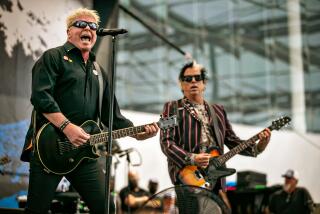Retromania: Pop’s past is taking over

We live in a pop age gone loco for retro and crazy for commemoration. Band reformations and reunion tours, tribute albums and box sets, anniversary festivals and live performances of classic albums: Each new year is better than the previous year for music from yesteryear.
Could it be that the greatest danger to the future of our music culture is ... its past?
Maybe that sounds unnecessarily apocalyptic. But the scenario I’m imagining isn’t a cataclysm so much as a gradual wind-down. This is the way that pop ends, not with a bang but with a box set whose fourth disc you never get around to playing and an overpriced ticket to the track-by-track restaging of the Pavement album you played to death in your first year in college.
Once upon a time, pop’s metabolism buzzed with dynamic energy, creating the surging-into-the-future feel of periods such as the psychedelic ‘60s, the post-punk ‘70s, the hip-hop ‘80s and the rave ‘90s. The 2000s felt different. The sensation of moving forward grew fainter as the decade unfurled.
If the pulse of now felt weaker with each passing year, that’s because in the 2000s, the pop present became ever more crowded out by the past, whether in the form of archived memories of yesteryear or retro-rock leeching off ancient styles. Rather than being about itself, the 2000s were about every other previous decade happening again all at once.
Instead of being the threshold to the future, the first 10 years of the 21st century turned out to be the “Re” Decade. The 2000s were dominated by the “re-” prefix: revivals, reissues, remakes, reenactments. Endless retrospection: Every year brought a fresh spate of anniversaries, with their attendant glut of biographies, memoirs, rockumentaries, biopics and commemorative issues of magazines. Then there were the band reformations, whether it was groups reuniting for nostalgia tours to replenish the members’ bank balances (Police, Led Zeppelin, Pixies) or as a prequel to returning to the studio to relaunch their recording careers (Stooges, Fleetwood Mac, My Bloody Valentine).
If only it were just the old music and old musicians coming back. But the 2000s was also the decade of rampant recycling: bygone genres revived and renovated, vintage sonic material reprocessed and recombined. Too often with new young bands, beneath their taut skin and rosy cheeks you could detect the sagging, gray flesh of old ideas.
As the 2000s proceeded, the interval between something happening and its being revisited seemed to shrink insidiously. The reissue industry’s tentacles have already reached the late ‘90s, with box sets and remastered/expanded versions of minimal techno, Britpop and even Morrissey’s lamest run of solo albums. As for revivals, the music scene mostly abided by the 20-Year Rule of Revivalism: The ‘80s were in for pretty much the entire 2000s. Then, right on cue, from last year onward you started to see glimpses of ‘90s revivalism, with the rise of grunge and Britpop as reference points for new bands such as Yuck and Brother.
The word “retro” refers to a self-conscious fetish for period stylization (in music, clothes, design) expressed creatively through pastiche and citation. But retro has come to be used in a more vague way to describe anything that relates to the relatively recent past of popular culture. This includes phenomena such as the vastly increased presence in our lives of old pop culture: from the availability of back-catalog records to YouTube’s gigantic collective archive and the massive changes in music consumption engendered by playback devices such as the iPod (often used as a personal “oldies” radio station).
Earlier eras had their own obsessions with antiquity, from the Renaissance’s veneration of Roman and Greek classicism to the Gothic movement’s invocations of medievalism. But there has never been a society in history so obsessed with the cultural artifacts of its own immediate past.
This kind of retromania has become a dominant cultural force to the point where it feels as if we’ve reached a tipping point. Is nostalgia stopping our culture’s ability to surge forward or are we nostalgic precisely because the culture has stopped moving forward?
I’m not alone in feeling perplexed by these developments. Sometimes it’s the musicians themselves who voice concern. In 2007, Sufjan Stevens declared: “Rock and roll is a museum piece. . . . There are great rock bands today — I love the White Stripes, I love the Raconteurs. But they’re just reenacting an old sentiment. They’re channeling the ghosts of that era — the Who, punk rock, the Sex Pistols, whatever. It’s been done.”
This malaise is not restricted to pop music, of course. Look at the Hollywood mania for remaking blockbuster movies from decades earlier: “Alfie,” “Casino Royale,” “The Pink Panther,” “Arthur” ... When it’s not revamping proven box-office successes of the past, the movie industry is adapting “iconic” TV series for the big screen, such as “The Dukes of Hazzard” and “Charlie’s Angels.”
Theater has a long tradition of reviving canonic plays and much-loved musicals, but here too you can see the remake and the spinoff catching on with productions such as “Spamalot” (based on “Monty Python and the Holy Grail”) and “jukebox musicals” written around golden oldies by legendary bands or from vintage genres. There are even “jukebox TV’” shows such as “Pop Idol” / “American Idol,” with their Beatles nights and Stones nights, and “Glee.”
There are also retro toys, retrogaming, retro food, retro interior design, retro architecture and retro porn.
Retro-consciousness nonetheless seems most chronically prevalent in music. That may well be because it somehow feels especially wrong there. Pop ought to be all about the present tense, surely? It’s still considered the domain of the young, and young people aren’t supposed to be nostalgic. Likewise, pop’s essence is the exhortation to “be here now.” Popular music’s connection to the new and the now explains its unparalleled capacity to distill the atmosphere of a historical era. In period-drama movies and TV, nothing conjures an era’s vibe more effectively than pop songs.
In terms of mainstream pop, many of the 2000s’ most commercially prominent trends involved recycling: the garage punk resurgence of the White Stripes, the Hives, Jet, the Kills, et al; the vintage-soul style of Amy Winehouse, Duffy, Adele and other young white females who pass for black American lady singers from the ‘60s; ‘80s synth pop-inspired femmes such as La Roux and Lady Gaga. But where retro truly reigns as the dominant sensibility is in hipsterland, pop’s equivalent to highbrow.
The very people you would once have expected to champion the nontraditional and the groundbreaking — that’s the group most addicted to the past. Instead of being pioneers and innovators, they’ve switched roles to become curators and archivists. From ‘60s garage-punk scholars such as Thee Oh Sees to outfits such as Emeralds and Oneohtrix Point Never, which are inspired by New Age and electronic “space music” of the ‘80s, the avant-garde is now an arrière-garde.
At a certain point, the sheer mass of past accumulating behind the music began to exert a gravitational pull. You could see this syndrome starting to emerge as far back as the ‘80s, but it’s really escalated in the last decade. Young musicians who’ve come of age these last 10 years have grown up in a climate where the musical past is accessible to an unprecedented degree. The result is music that involves a meticulously organized constellation of reference points and allusions that span the decades and the oceans.
It’s not that nothing happened in the music of the 2000s. In many ways, there was a manic bustle of micro-trends and subgenres. But by far the most momentous transformations related to our modes of consumption and distribution. We’ve become victims of our ever-increasing capacity to store, organize, instantly access and share vast amounts of cultural data.
Yet this is not a straightforward denunciation of retro as a manifestation of cultural regression. How could it be, when I’m complicit myself? As much as I’ve written as a journalist and author about “brave new frontier” musics such as rave and post-punk, I’m also an avid participant in the retro culture: as a historian, a reviewer of reissues, a talking head in rock docs. As a fan, I’m as addicted to retrospection as anybody: Trawling the second-hand record shops, poring over rock books, glued to YouTube. I pine for the future that’s gone AWOL on us, but I also feel the lure of the past.
I’ve had plenty of love for bands that could easily be dismissed as mere pastiche. It’s caused me to resort to ingenious arguments to explain why a particular adored band is not just another grave-robbing necrophile. The most recent example is Los Angeles-based cult musician Ariel Pink. Without a trace of embarrassment, Ariel describes his sound, woven out of blurry echoes of halcyon radio pop from the ‘60s, ‘70s and ‘80s, as “retrolicious.” And it is! Nostalgia is, after all, one of the great pop emotions. And sometimes that nostalgia can be the bittersweet longing pop feels for its own lost golden ages. And yet.... surely there’s something profoundly disquieting that so much of the greatest music made in recent years — from Ariel Pink’s “Before Today” to Cee Lo Green’s “Forget You” — sounds as if it could have been made 30 or 40 years before.
What could break this deadlock? It’s conceivable that the current malaise of retrospection and derivativeness is just a phase, a sort of shell-shocked state induced by the instant access/total access to pop’s archives facilitated by digital culture. It could be that the new generation of musicians, who’ve grown up with no experience of music before the Internet, will forge a new relationship with music that isn’t stifled by homage and heritage. This coming generation comfortably inhabits a new form of cultural temporality in which past, present and future are totally jumbled. “Is it innovative?” is no longer a question they’re even asking.
For old-fashioned modernist music fiends like myself, though, it will be hard to forget that one has repeatedly experienced the shock of the new during one’s listening lifetime, from Donna Summer’s 1977 electronic disco classic “I Feel Love” to ‘90s techno-rave, from Talking Heads’ “Once in a Lifetime” to the cyberfunk of Missy Elliott and Timbaland. Me and my kind will always ache for that “never heard anything like this before” sensation.
A massive jolt to music might come from a breakthrough in technology, or from a new drug or, better still, the synergistic combination of both (as happened with Ecstasy and techno’s machine rhythms). There is another possibility: The next wave of renewal could come from outside the Anglo-American pop tradition altogether, from the developing world or the demographic powerhouses of Brazil, China and India. Their overdriven economic metabolisms will generate all manner of social tensions and cultural rifts, which could spawn some 21st century musical form that will take the world by storm just like jazz and rock ‘n’ roll did in their day.
This article is adapted from “Retromania: Pop Culture’s Addiction to Its Own Past,” published this month by Faber & Faber. Reynolds is also the author of “Rip it Up and Start Again” and “Generation Ecstasy.” He will be discussing his new book at Skylight Books in Los Feliz at 5 p.m. July 31.
More to Read
The biggest entertainment stories
Get our big stories about Hollywood, film, television, music, arts, culture and more right in your inbox as soon as they publish.
You may occasionally receive promotional content from the Los Angeles Times.






